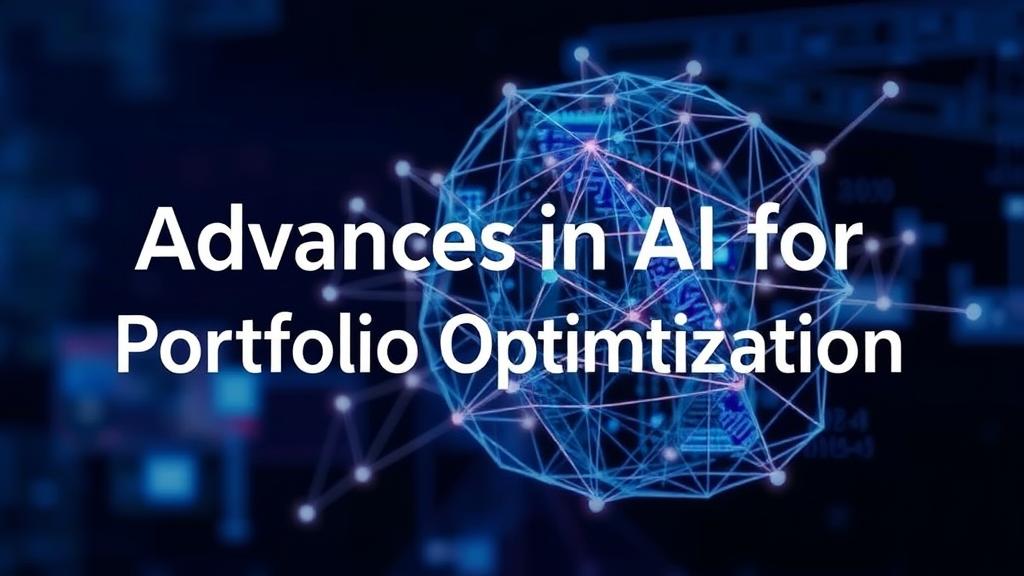Inviting Exploration of Advanced Strategies
Curious about how advanced algorithms are influencing investment strategies? Let’s dive into the mechanics of modern trading.
Advances in AI for Portfolio Optimization
The world of finance is constantly evolving, and the integration of artificial intelligence (AI) in portfolio optimization is one of the most significant advancements in recent years. As investors seek to maximize returns while managing risk, AI offers innovative solutions that have the potential to transform investment strategies. This article delves into the key advancements in AI for portfolio optimization, exploring how these technologies are reshaping the landscape of investment management.
Before delving into AI advancements, it’s essential to grasp the fundamentals of portfolio optimization.
What is Portfolio Optimization?
Portfolio optimization is the process of selecting the best mix of assets to achieve specific investment goals. This typically involves balancing risk and return, ensuring that the potential for profit aligns with an investor’s risk tolerance.
Key Concepts in Portfolio Optimization
- **Risk Tolerance:** Understanding how much volatility an investor can withstand.
- **Expected Return:** Estimating the potential profit from an investment.
- **Diversification:** Spreading investments across various assets to reduce risk.
- **Efficient Frontier:** A graph representing the best possible expected return for a given level of risk.
The Role of AI in Portfolio Optimization
AI has revolutionized portfolio optimization by introducing sophisticated models and algorithms that facilitate data analysis, risk assessment, and decision-making.
Machine Learning: A Game Changer
Machine learning (ML) is a subset of AI that allows systems to learn from data and improve over time without explicit programming. In portfolio optimization, ML algorithms can analyze vast datasets to identify patterns and trends that inform investment decisions.
How Machine Learning Enhances Portfolio Optimization
- Predictive Analytics:** ML models can forecast asset price movements based on historical data, helping investors make informed decisions.
- Dynamic Rebalancing:** Algorithms can continuously assess portfolio performance and adjust asset allocations in real time.
- Sentiment Analysis:** By analyzing news articles, social media, and other sources, AI can gauge market sentiment and its potential impact on asset prices.
Natural Language Processing (NLP)
Natural Language Processing, another branch of AI, focuses on the interaction between computers and human language. NLP can be utilized in portfolio optimization to extract insights from unstructured data.
Applications of NLP in Portfolio Optimization
- Market Sentiment Analysis:** By interpreting large volumes of textual data, NLP can assess investor sentiment and market trends.
- Risk Management:** NLP can identify potential risks by analyzing news reports and social media for negative sentiment or emerging threats.
Advanced Algorithms and Techniques
AI-driven portfolio optimization employs complex algorithms that enhance traditional methods. Some notable techniques include:
Genetic Algorithms
Genetic algorithms mimic the process of natural selection to optimize investment portfolios. By simulating the evolutionary process, these algorithms find optimal asset combinations over multiple iterations.
Key Features of Genetic Algorithms
- Selection:** Choosing the best-performing portfolios based on preset criteria.
- Crossover:** Combining two or more portfolios to create a potentially superior portfolio.
- Mutation:** Introducing random changes to enhance diversity and explore new potential solutions.
Reinforcement Learning
Reinforcement learning (RL) involves training models to make decisions based on rewards and penalties. In portfolio optimization, RL can help in adjusting investment strategies dynamically.
How Reinforcement Learning Works
- **Agent:** The AI model that makes decisions regarding asset allocation.
- **Environment:** The market conditions and asset performance that influence decision-making.
- **Rewards:** The returns generated from investments, which guide the learning process.
Real-World Applications of AI in Portfolio Optimization
Several financial institutions and investment firms have begun leveraging AI for portfolio optimization. Here are some notable examples:
1. BlackRock
BlackRock, one of the world’s largest asset management firms, employs AI to enhance its investment strategies. The firm utilizes machine learning to analyze market trends and optimize portfolios, enabling them to respond more effectively to market changes.
2. JPMorgan Chase
JPMorgan Chase has developed a proprietary AI tool called “COiN†(Contract Intelligence), which helps analyze legal documents and extract relevant data. This technology aids in portfolio management by identifying risks and opportunities within investment contracts.
3. Wealthfront
Wealthfront, a robo-advisor, employs AI algorithms to create personalized investment portfolios based on individual risk profiles and financial goals. By utilizing machine learning, the platform continually monitors and adjusts portfolios to maximize returns.
Challenges and Future Directions
Despite the advancements in AI for portfolio optimization, several challenges exist.
Data Quality and Availability
- Data Integrity:** Ensuring the accuracy and reliability of data used for AI models is critical.
- Data Overload:** The sheer volume of data can overwhelm traditional systems, necessitating robust data management solutions.
Regulatory Considerations
As AI becomes more prevalent in finance, regulatory bodies are starting to scrutinize its use. Investment firms must navigate complex regulations while adopting AI-driven solutions.
Ethical Considerations
The use of AI raises ethical questions regarding transparency and bias in decision-making. Firms must ensure their algorithms are fair and do not inadvertently discriminate against certain groups of investors.
Conclusion
The integration of AI in portfolio optimization represents a transformative shift in the investment landscape. By harnessing the power of machine learning, natural language processing, and advanced algorithms, investors can make more informed decisions, manage risks effectively, and optimize returns. However, as the technology continues to evolve, it is crucial for financial institutions to address challenges related to data quality, regulation, and ethics. As we look to the future, AI’s role in portfolio optimization will likely expand, paving the way for more innovative and efficient investment strategies. Embracing this technology can lead to a more dynamic and responsive investment environment, ultimately benefiting investors and financial markets alike.



